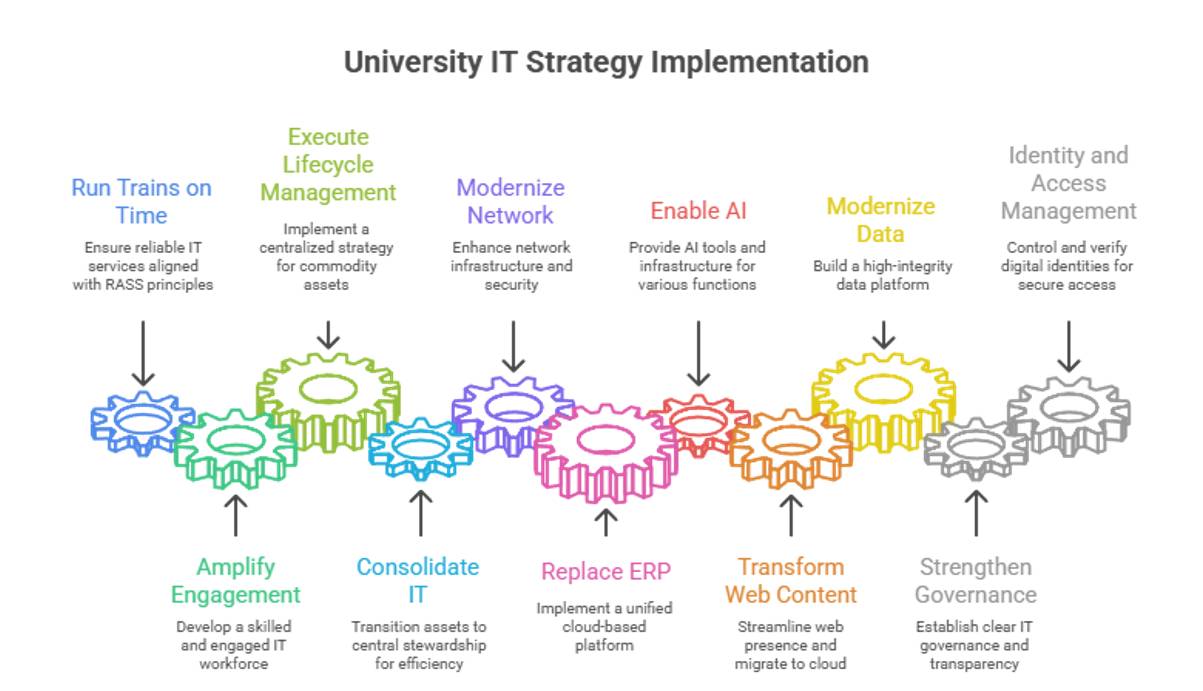Texas State University is undertaking a comprehensive transformation of its Information Technology to ensure services are secure, scalable, and aligned with the university’s mission.
Our priority is operational excellence, ensuring services are reliable, cost-effective, and resilient. This includes extensive custom development and reporting to support administration, research, teaching, and student success. It is the foundation for everything we do.
Building on that foundation, we are executing a multi-year transformation plan anchored in interdependent initiatives. These efforts modernize infrastructure, centralize oversight, and expand access to secure, high-integrity systems and data. From lifecycle management and ERP to AI and Zero Trust, our strategy emphasizes transparency, sustainability, and shared governance.
This is not just a technical transformation but an organizational one. We eliminate redundancy, standardize provisioning, and support ubiquitous access. A next-generation network supports dense, secure connectivity, including consumer devices such as Xbox, Televisions, and Alexa Devices. New AI and analytics capabilities will empower teaching, research, and decision-making. A streamlined web presence and governance model will ensure a modern, coherent digital footprint.
Together, these efforts create a future-ready IT foundation that evolves in tandem with Texas State’s aspirations.

Key Initiatives for IT Transformation
- Run the Trains on Time: Deliver secure, reliable, cost-effective, and resilient IT services, aligned with the RASS principles of Reliability, Availability, Serviceability, and Security, including real-time monitoring of critical services.
- Amplify Engagement and Workforce Development: Recruit, retain, and develop a highly skilled, engaged, and mission-aligned IT workforce through intentional career development, inclusive culture building, and strategic workforce planning.
- Execute Technology Lifecycle Management: Implement a centralized lifecycle strategy for commodity assets, including procurement, support, and lifecycle refresh. This includes standard personal computers, network infrastructure, digital signage, classroom AV equipment, wireless access points, and enterprise servers.
- Consolidate Institutional IT and Align Support Models: Transition general-use technology assets to central stewardship, reducing administrative overhead and financial fragmentation while enabling consistent, persona-based provisioning and lifecycle across the university.
- Modernize Network and Expand Secure Access: Modernize core and edge infrastructure, increase wireless density, and implement Zero Trust Architecture to support secure, high-density, and scalable connectivity across the campus, ensuring the safe coexistence of enterprise and consumer devices.
- Replace ERP with Unified Cloud System: Implement a unified cloud-based Student, Finance, and HCM platform to replace aging ecosystems reaching end-of-life in December 2030.
- Enable AI Across Teaching, Research, and Administration: Provide secure, legal, and policy-compliant AI tools and infrastructure to support teaching, research, and administration.
- Transform Web Content Management: Streamline institutional web presence to enable AI tools through up-to-date content management and migration to cloud-based hosting.
- Modernize Data and Analytics: Build a high-integrity data platform with governed access and self-service analytics. Liberate the data.
- Strengthen Transparency, Planning, and IT Governance: Establish clear visibility into IT spending, define service-level objectives, and implement service costing through a formal governance structure that distinguishes between "common good" and specialized local expenses.
- Identity and Access Management: Control and verify digital identities to ensure secure access.